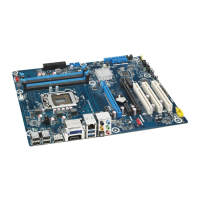Product Description
37
its last known wake state. Table 12 on page 34 lists the devices and events that can
wake the computer from the S3 state.
The board supports the PCI Bus Power Management Interface Specification. Add-in
boards that also support this specification can participate in power management and
can be used to wake the computer.
The use of Instantly Available PC technology requires operating system support and
PCI Express add-in cards and drivers.
1.11.2.5 Wake from USB
USB bus activity wakes the computer from an ACPI S3 state.
NOTE
Wake from USB requires the use of a USB peripheral that supports Wake from USB.
1.11.2.6 PME# Signal Wake-up Support
When the PME# signal on the Conventional PCI bus is asserted, the computer wakes
from an ACPI S3, S4, or S5 state (with Wake on PME enabled in the BIOS).
1.11.2.7 WAKE# Signal Wake-up Support
When the WAKE# signal on the PCI Express bus is asserted, the computer wakes from
an ACPI S3, S4, or S5 state.
1.11.2.8 Wake from Consumer IR
CIR activity wakes the computer from an ACPI S3, S4, or S5 state.
1.11.2.9 Wake from S5
When the RTC Date and Time is set in the BIOS, the computer will automatically wake
from an ACPI S5 state.
1.11.2.10 Power Supervisor
The Power Supervisor actively monitors the input voltages from the power supply and
protects the board and any attached peripherals from electrical overstress and possible
physical damage. The Power Supervisor will activate if it detects the power supply
voltage rails have deviated outside the current ATX power supply specification and safe
operating levels.
If the Power Supervisor detects an out of spec voltage, the following will happen:
1. The board will be powered down immediately to protect circuits from electrical
overstress and possible physical damage.
2. A red warning LED (see Figure 1) on the board will activate as a visual cue.

